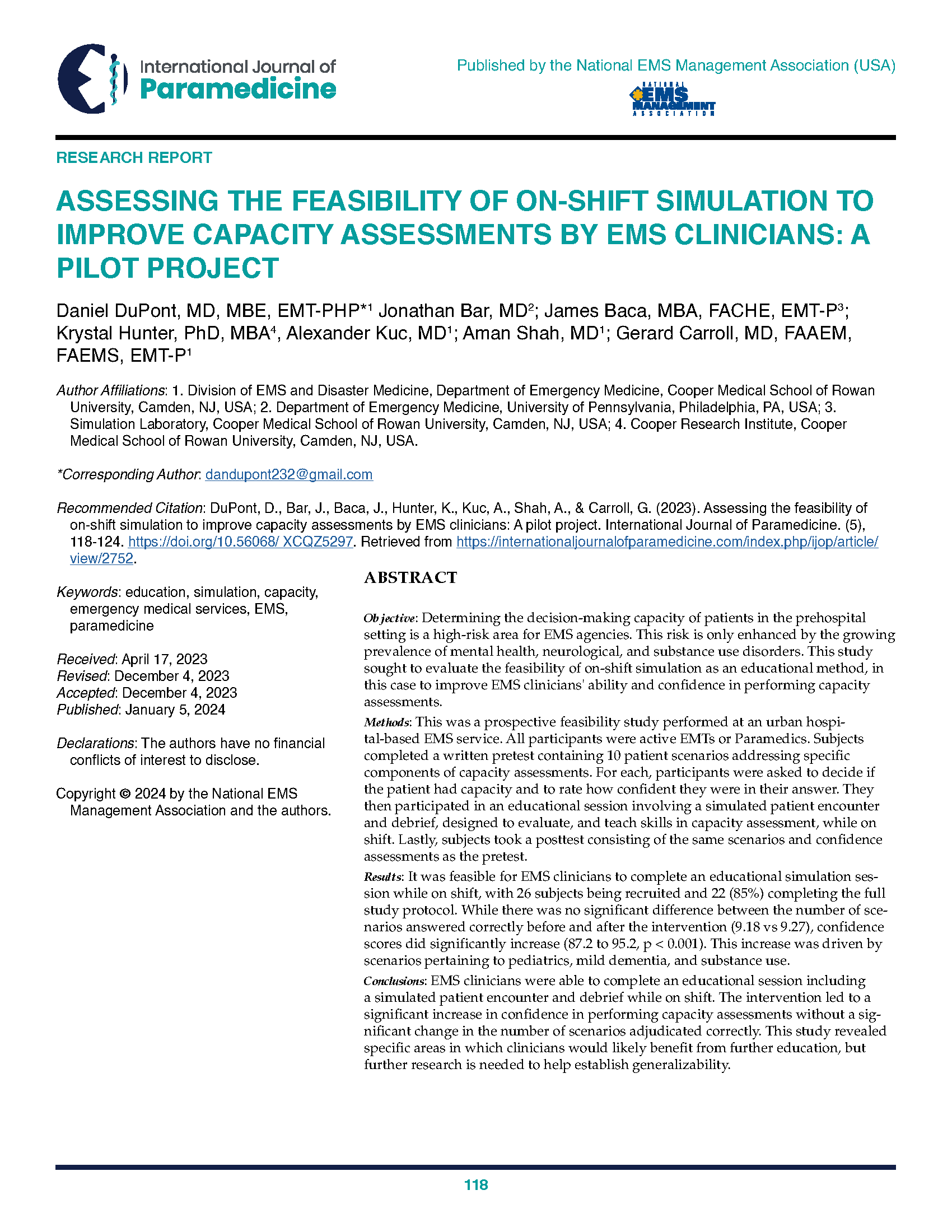Assessing the Feasibility of On-Shift Simulation to Improve Capacity Assessments by EMS Clinicians A Pilot Project
Main Article Content
Abstract
Objective
Determining the decision-making capacity of patients in the prehospital setting is a high-risk area for EMS systems. This risk is only enhanced by the growing prevalence of mental, neurological, and substance use disorders. This study sought to evaluate the feasibility of on-shift simulation as an educational method, in this case to improve EMS clinicians’ ability and confidence in performing capacity assessments.
Methods
This was a prospective experimental feasibility study performed at an urban, tertiary, academic medical center that operates its own EMS service. All participants were active EMTs or Paramedics. Subjects completed a pretest containing 10 patient scenarios addressing specific components of a complete capacity assessment. For each, participants were asked to decide if the patient had capacity and to rate how confident they were. They then participated in a simulated encounter with a standardized patient, designed to evaluate and teach skills in capacity assessment. A post-scenario debrief and didactic session were conducted. Lastly, subjects took a post-test consisting of the same 10 scenarios and confidence assessments.
Results
22 subjects completed the study. While there was no significant difference between the number of scenarios answered correctly before and after the intervention (9.18 vs 9.27), participants’ confidence scores did significantly increase (87.2 to 95.2, p < 0.001). This increase was driven by scenarios pertaining to mild dementia, pediatrics, and substance use.
Conclusions
Prehospital clinicians were able to correctly assess capacity in a variety of scenarios. A didactic session including a simulated patient encounter led to a significant increase in participants’ confidence in performing capacity assessments. This study revealed specific areas in which clinicians would likely benefit from further education, but further research is needed to ensure generalizability.
Article Details

This work is licensed under a Creative Commons Attribution-ShareAlike 4.0 International License.
Publishing in IJOP allows authors to keep their copyright while giving IJOP unrestricted copyright permissions. Articles published in IJOP use Creative Common Attribution 4.0 International (CC BY-ND 4.0) licensing. This license requires that re-users give credit to the creator. It allows re-users to copy and distribute the material in any medium or format in unadapted form only, even for commercial purposes. Additional terms apply and can be accessed here.
Publishing in IJOP also allows authors to have contracts for non-exclusive distribution of the Journal's published version of the article, such as posting to an institutional repository or publication in a book, on the condition that the original publication in the original layout format in IJOP is retained and acknowledged.
We permit and encourage authors to post the articles they published in IJOP on their affiliated websites. This helps share the information, encourages citation in other works, and promotes scholarly discourse in the spirit of open access.
References
Colwell, C. B., Pons, P., Blanchet, J. H., & Mangino, C. (1999). Claims against a paramedic ambulance service: a ten-year experience. The Journal of emergency medicine, 17(6), 999-1002. https://doi.org/10.1016/S0736-4679(99)00131-6
Duncan, E. A., Best, C., Dougall, N., Skar, S., Evans, J., Corfield, A. R., ... & Wojcik, W. (2019). Epidemiology of emergency ambulance service calls related to mental health problems and self harm: a national record linkage study. Scandinavian journal of trauma, resuscitation, and emergency medicine, 27(1), 1-8. https://doi.org/10.1186/s13049-019-0611-9
Lee Gordon, D., Issenberg, S. B., Gordon, M. S., LaCombe, D., McGaghie, W. C., & Petrusa, E. R. (2005). Stroke training of prehospital providers: an example of simulation-enhanced blended learning and evaluation. Medical Teacher, 27(2), 114-121. https://doi.org/10.1080/01421590400029756.
Gurnáková, J., & Gröpel, P. (2019). Prior participation in simulation events is associated with insimulation team performance among emergency medical services professionals. Simulation in Healthcare, 14(4), 235-240. https://doi.org/10.1097/SIH.0000000000000371.
Hall, R. E., Plant, J. R., Bands, C. J., Wall, A. R., Kang, J., & Hall, C. A. (2005). Human patient simulation is effective for teaching paramedic students endotracheal intubation. Academic Emergency Medicine, 12(9), 850-855. https://doi.org/10.1197/j.aem.2005.04.007.
Knowlton, A., Weir, B. W., Hughes, B. S., Southerland, R. H., Schultz, C. W., Sarpatwari, R., ... & Gaasch, W. (2013). Patient demographic and health factors associated with frequent use of emergency medical services in a midsized city. Academic Emergency Medicine, 20(11), 1101-1111. https://doi.org/10.1111/acem.12253.
Larkin, G. L., Claassen, C. A., Pelletier, A. J., & Camargo, C. A. (2006). National study of ambulance transports to United States emergency departments: importance of mental health problems. Prehospital and disaster medicine, 21(2), 82-90. https://doi.org/ 10.1017/s1049023x0000340x.
McKenna, K. D., Carhart, E., Bercher, D., Spain, A., Todaro, J., & Freel, J. (2015). Simulation use in paramedic education research (SUPER): a descriptive study. Prehospital Emergency Care, 19(3), 432-440. https://doi.org/10.3109/10903127.2014.995845
Morgan, D. L., Wainscott, M. P., & Knowles, H. C. (1994). Emergency medical services liability litigation in the United States: 1987 to 1992. Prehospital and Disaster Medicine, 9(4), 214-220. https://doi.org/10.1017/S1049023X0004142X
O'Connor, L., Porter, L., Dugas, J., Robinson, C., Carrillo, E., Knowles, K., ... & Rebesco, M. (2020). Measuring agreement among prehospital providers and physicians in patient capacity determination. Academic Emergency Medicine, 27(7), 580-587. https://doi.org/10.1111/acem.13941.
Patel, V., Chisholm, D., Parikh, R., Charlson, F. J., Degenhardt, L., Dua, T., ... & Whiteford, H. (2016). Addressing the burden of mental, neurological, and substance use disorders: key messages from Disease Control Priorities. The Lancet, 387(10028), 1672-1685. https://doi.org/ 10.1016/S0140-6736(15)00390-6.
Rehm, J., & Shield, K. D. (2019). Global burden of disease and the impact of mental and addictive disorders. Current psychiatry reports, 21, 1-7. https://doi.org/ 10.1007/s11920-019-0997-0.
Riley, J., Burgess, R., & Schwartz, B. (2004). Evaluating the Impact of an Educational Intervention on Documentation of Decision?making Capacity in an Emergency Medical Services System. Academic emergency medicine, 11(7), 790-793. https://doi.org/10.1197/j.aem.2004.01.005.
Wang, H. E., Fairbanks, R. J., Shah, M. N., Abo, B. N., & Yealy, D. M. (2008). Tort claims and adverse events in emergency medical services. Annals of emergency medicine, 52(3), 256-262. https://doi.org/ 10.1016/j.annemergmed.2008.02.011.
Weaver, J., Brinsfield, K. H., & Dalphond, D. (2000). Prehospital Refusal-of-transport Policies: Adequate Legal Protection? Prehospital Emergency Care, 4(1), 53-56. Prehosp Emerg Care. 2000;4(1):535-6. https://doi.org/10.1080/10903120090941650.

